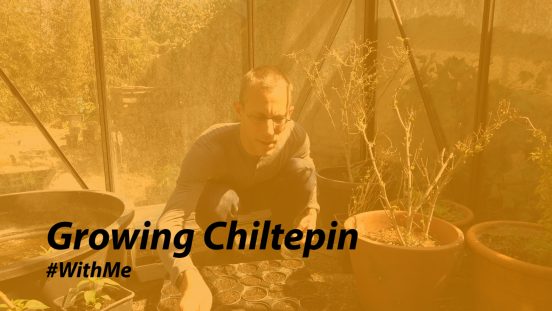It’s a bit late in the year (I’m starting this mid-May), but I couldn’t resist some chiltepin – and that should still work.
Let’s go and see about it, then!
Chiltepin is the wild forebear of the largest diversity of chile peppers; all the peppers that belong to Capsicum annuum come from this type of chilli.
That makes this plant with pea-sized spicy pods the trunk of the evolutionary tree from which everything from cherry peppers and cayennes to mild vegetable peppers branched out.
Chiltepin have long been a fascination of mine.

They were considered difficult, if not impossible, to grow, but turned out to be the chilli that is easiest to overwinter and keep for years.
They also have some spicy characteristics that are just too interesting; those tiny pods of theirs hide a strong pungency and a flavor that is great and subtle.
Chiltepin Growing Hints
If you want to grow chiltepin yourself, here’s what I’ve found to help:
Seeds
Perhaps the most important factor to successfully growing chiltepin is getting high-quality seeds.
This may sound like it’s a matter of course, but I have, over the years, seen only too many chilli seed sellers who sold something as chiltepin that definitely wasn’t.
Sometimes, it even looked like the idea that chiltepin was hard to grow may have come from – or been used by – seed sellers who sold seeds that were simply not viable.
Thus, step one: Get high-quality seeds from a good source. Someone like Native Seeds/Search is ideal; they can even tell you where (near-)exactly those seeds originally came from.

Germination
Much has been made of germination of those seeds being really difficult.
When they are not good, it may easily be impossible.
With a few “accessions” of chiltepin (i.e., ones from different places, brought into plant seed banks), I have seen a seed dormancy.
These really took longer until they suddenly decided to germinate.
Usually, though, chiltepin seeds can be treated – and germinate – like any other chilli.
Sowing Chiltepin
Just put the seeds into a (seed-starting) potting mix, covered by soil to about 2-5 times the seeds’ diameter (meaning, they should be under the soil and remain there when watering, but not be buried too deep).
Keep moist and warm.
Wait for it.
That’s what I have done so far this year; next steps, with a next video – hopefully ;)
Chiltepin I’ve Started
Oh, I guess I should add in what types of tepin I’m now trying – which are actually not all tepin:
- Sonoran Chiltepin (red)
- Sonoran Chiltepin amarillo (yellow-ripening pods)
- Sonoran Chiltepin cappuccino (brown-ripening pods)
- Chiltepin XS – I don’t know the name/label anymore; it might well have been DOI002/B
- Three other chiltepin I’ve been growing the longest
- Bird Ají (not a chiltepin, but a tepin-like wild “bird pepper” belonging to the species Capsicum baccatum)
- Charapita (also called ají charapita; it looks like a tepin again, but clearly belongs to Capsicum chinense)
One of the interesting things to observe – provided things work out as they ordinarily should:
The charapita seeds were probably pretty old, thus might not germinate anymore.
The bird ají seeds are from 2017, if I labeled them right, which is probably at the limit for their viability.
The Sonoran chiltepines and the XS seeds are from last year; those should germinate well; the other chiltepin seeds are a mix of older and newer, so we’ll see…

Leave a Reply
You must be logged in to post a comment.